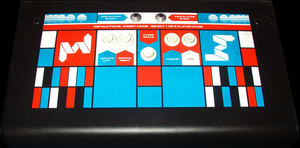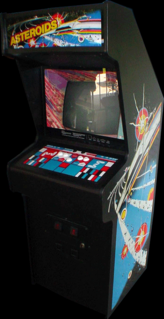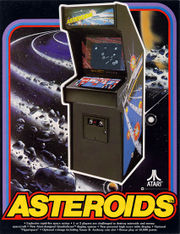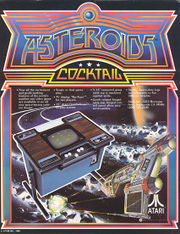Lost In Translation/Asteroids
| Asteroids | |
|---|---|
| Manufacturer | Atari |
| Released | 1979 |
| Control Method |
5 Button(s) |
| Main CPU | M6502 (@ 1.512 MHz) |
| Sound CPU | Mono Discrete |
| Video Details |
Vector (Horizontal) 0 x 0 pixels 60.00 Hz 32,768 Palette colours |
| Screens | 1 |
| ROM Info | 5 ROMs 8,448 bytes (8.25 KiB) |
| MAME ID | asteroid · asterock · asteroi1 · asteroib · meteorts |
About The Game
Asteroids is another legendary, genre defining game - in an era replete with genre defining classics - in which a single player takes control of a ship trapped in the middle of an asteroid field. A number of large, slow-moving asteroids drift randomly around the play area and must be shot by the player. When shot, the asteroids will break into a number of smaller pieces which must also be shot until eventually, all of the asteroids and fragments will be destroyed and the next wave begins.
Asteroids introduced real-world physics to video-games for the first time, with speed and inertia all adding to the player's problems. As well as the inertia of the player's ship - forcing the player to allow for the ship slowing down and speeding up whenever the Thrust button was utilized - shot asteroids would often send fragments flying in seemingly random directions, and at varying and unpredictable speeds.
As well as the ever-present asteroids, alien saucers also make a regular appearance. These move diagonally around the screen firing at the player's ship and must be quickly destroyed.
Cast of Characters
Spaceship - This is you, the player. You can rotate 360 degrees, fire bullets, thrust forward in any direction, and hyperspace to safety if you feel you are in danger.
Large Asteroid - These are the large rocks that fill the screen at the beginning of each stage. Hitting one with a bullet will break it apart in to 2 Medium Asteroids.
Medium Asteroid - Slightly smaller than Large Asteroids, but faster moving. Shooting one of these will result in two Small Asteroids.
Small Asteroid - These are the smallest and fastest rocks on the screen. If a bullet hits one of these, they will vaporize.
Large Saucer - Large flying saucers appear on the screen from time to time, randomly firing shots around the screen. They pose a minor threat.
Small Saucer - The smaller saucers are more deadly than the large variety. They are much more precise with their shots, and are more likely to kill you. Eliminate them quickly or get out of their range.
Additional Technical Information
Players : 2
Buttons : 5
=> RIGHT, LEFT, FIRE, THRUST, HYPERSPACE
Trivia
Released in November 1979.
Licensed to Sega for Japan market.
Originally called 'Cosmos', Asteroids' original design brief was a simple copy of "Space Wars (Cinematronics)"; with asteroids littering the play-field purely for visual effect. 'Cosmos' was also once known as 'Planet Grab', in which the player had to claim a planet by touching it with their spaceship. 'Cosmos' allowed players to blow up the planets and duel with another ship, Space Wars-style. Only in Asteroids, which arrived 2 years later, did Atari engineer, Lyle Rains, introduce the concept of free-floating rocks.
On 17 June 1980, Atari's Asteroids and "Lunar Lander" were the first 2 video games to ever be registered in the Copyright Office.
The first 200 Asteroids machines were actually "Lunar Lander" cabinets; Asteroids was so successful that Atari cut Lunar Lander's production run and released the 200 aforementioned machines, complete with their original Lunar Lander cabinet art.
Asteroids remains Atari's bestselling arcade game of all time, with approximately 56,565 units produced (47,840 upright and 8,725 cocktail) in total.
- Remembrances from the Video Game Masters : working on Asteroids was so intense that Lyle Rains and Ed Logg often dreamt about their work. Lyle Rains : 'In the course of my work I have always found that there are times during the development process when the project gets to me in such a way that I'm eating, drinking, sleeping, and breathing the project. When I close my eyes the images of the screen are there and I dream about them at night. There is something just very intense when you live with a project like that day and night, for months at a time. When we were working on Asteroids, I would play Asteroids for a number of hours in the evening, then I'd go home and I'd close my eyes, and as I was drifting off to sleep I'd see the asteroids floating around the screen.'.
Ed Logg : 'I was shooting the asteroids all night long; I'd just play the game over and over and over in my head, just as if you were playing it in real life. To a certain extent, I play a lot of the games in my mind long before I ever write them because you have to get all the interactions down pat before you can start programming. I know what it's going to look like before I even get there.'.
- Popular from the Start : a good barometer of a game's future success was how popular it was within the labs at Atari. The software developers often had to chase people away from their Prototype machines when they arrived at their desks in the morning or returned from lunch. Lyle Rains : 'The development on the really good games gets bogged down, because people want to play them all the time. I was in the lab quite often playing Asteroids, as were many other people.'.
On the overall popularity of Asteroids, Steve Calfee said : 'A lot of people really liked it. Somehow, there's something about people, they like to clean spaces. With Asteroids it's easy to measure your accomplishment, you're breaking big rocks into little rocks and then the little rocks into nothing. It's sort of a metaphor for life.'.
Rich Adam recalled his own first encounter with Asteroids : 'I'll never forget going into the lab and seeing that game for the first time. It was like an adrenaline rush. I'm out flying this spaceship and it's the miraculous escape. I've got this situation where I've got tons of these boulders flying around the screen, I have almost nowhere to go. I get to blast my way out of it and cheat death one more time; that's a good fantasy, you've got all these things flying around and yet you're able to survive.'.
Howard Delman described what it was like creating the sounds for Asteroids : 'In those days there were no all-purpose sound chips like we have now, so I had to create a hardware circuit for each sound. I would string together electrical circuits that would produce an output wave-form that corresponded to the wave-form of the sound. When put through an amplifier and a loud-speaker, it would sound like whatever I was trying to create. The boom-boom-boom background sound was sort of meant to be like a heartbeat, and the idea was that as the game progressed, the sound speeded up, and the player's heart would speed up, too. You know, stress!'.
- The Great 25-Cent Escape : On the intensity of playing Asteroids, Ed Rotberg recalled : 'Asteroids was just so intense in the fact that you had a concept of all around fantasy. You had to keep your eyes constantly in motion around the screen because the danger could be coming from any direction, at anytime, and it was always so imminent. In Asteroids it was just you out there, trying to survive. It's an incredibly intense game. The tuning in terms of how fast the spaceship turns and how fast the bullets move and how far they go and how fast the asteroids can go, just all the tuning that Ed Logg put into that, is real artistry.'.
Asteroids is considered, artistically, to be a video-game masterpiece. Ed Logg opines : 'The simple fact that the spaceship in Asteroids continues to move after you cut thrust, providing a wee glimpse of the Newtonian mechanics of actual space flight, triggered the imaginations of many users'.
Rich Adam said : 'Asteroids fulfilled the fantasy of being out in space, with no gravity, and free floating. The spaceship had a very elegant grace. A lot of motion in the game had grace, even the way the boulders floated around.'.
And the game's epic quality was noted by Ed Rotberg : 'What Asteroids allows players to do is to put themselves in an incredible predicament, and then extricate themselves from it. You feel like a hero coming out of it.'.
There was a modified version of Asteroids that was given the nick-name "Turtleroids"; this was part of a long series of practical jokes against the vice-president of marketing for Atari who was feeling jaded in his feeling towards a game concept called 'Turtle Races'. One day, Ed switched the PROMs of the golden edition of Asteroids in the lobby of Atari so that the little and big UFOs were replaced by turtles, thus providing them with a constant reminder. Another practical joke involving Asteroids was a slight modification in the prototype of the game, because Owen Rubin (initials ORR on most Atari high score tables) kept filling up the high score tables when the programmers were not around. So, they modified the program to replace Owen's initials with Ed's own to keep him away.
In a monumental display of overconfidence on the part of the Atari programmers, Asteroids rolls over at only 99,999 points. Several players during days-long marathon games have scored over 100,000,000...
Asteroids keeps track of up to 255 extra men. If the player has too many, the game may slow down, probably due to the processor having to draw all the extra men on the screen.
Scott Safran holds the official record for this game with 41,336,440 points (!) on November 13, 1982.
An Italian bootleg released by Sidam is known as "Asterock". Another version is known as "Meteorites".
The default high score screen of "Cyberball 2072" features names of many Atari arcade games, including ASTEROID.
Asteroids inspired a catchy hit song by Buckner and Garcia called 'Hyperspace' released on the 'Pac-Man Fever' album.
An Asteroids unit appears in the 1982 movie 'Fast Times at Ridgemont High', in the 1983 movie 'WarGames', in the 1983 movie 'Terms of Endearment', in the 1983 movie 'Joysticks', in the 1984 movie 'Night of the Comet', in the 1984 movie 'The Iceman', in the 1985 movie 'Remo Williams - The Adventure Begins' and in the 1983 movie 'The Adventures of Bob & Doug McKenzie - Strange Brew'.
An upright Asteroids unit appears in the 38 Special music video 'Caught Up In You'.
Updates
The Rev.1 version had an invulnerability glitch, which allowed players to hide in the upper corners of the screen (in the score) and be invulnerable to collisions. Also, players could make their ship fly backwards by thrusting in one direction until reaching full speed, and then quickly turn around 180 degrees and continue thrusting.
The Rev.2 version says '1979 Atari' at the bottom of the title screen, instead of the 'Asteroids by Atari' that was displayed in Rev.1. Also, the invulnerability glitch of Rev.1 is corrected.
Scoring
| Target | Points |
|---|---|
| Large Asteroid | 20 |
| Medium Asteroid | 50 |
| Small Asteroid | 100 |
| Large Saucer | 200 |
| Small Saucer | 1000 |
Tips and tricks
When you start the game, your spaceship will be in the middle of the screen with 4 large asteroids heading toward your ship. After all the rocks are destroyed, the next round begins. The number of initial large asteroids depends on the round number :
| Round | Asteroids |
|---|---|
| 1 | 4 |
| 2 | 6 |
| 3 | 8 |
| 4 | 10 |
| 5 and up | 11 |
Your job is to blast those rocks. However, when you blast them, they break up into 2 medium rocks. Blasting a medium rock gives you 2 small rocks. Note : There is an exception to this rule. The game program only allows 26 asteroids on the screen at any one time. If the screen already contains 26 asteroids of any size, then when you shoot a large asteroid it breaks up into only one medium asteroid, and when you shoot a medium asteroid it breaks up into only one small asteroid. You can completely destroy a large asteroid with only 3 shots instead of 7 when the screen is filled up like this.
In addition, you have to contend with large and small saucers. On the first few screens, you can sit in the middle and blast rocks to your hearts content. There isn't that much danger since the large saucer doesn't track and only fires random shots. Keep in mind a couple of things when shooting :
- You can have 4 shots on the screen at any one time. This is useful for when you are blasting rocks at close range. You can pretty much drill them to dust.
- Your shots 'wrap around' the screen. This means any shot that goes past the edge of the screen will reappear on the opposite side traveling the same direction. The saucers also have 'wrap around' shots.
- After 10,000 points, the small saucer becomes a permanent part of the game. You can no longer sit in one place since the small saucer is able to track your ship and take you out with the first or second shot.
- Use hyperspace only in very desperate situations. Something like having 4 asteroids coming at you at once, and there is nowhere to escape would be a good reason. 8 times out of 10, hyperspace will either put your ship in danger or when you appear somewhere else, your ship will blow up.
- Although there is danger from the rocks and saucers, you can also be a danger to yourself. Use the thrust carefully or you will find yourself careening out of control on the screen. Some players get really good, however, moving around and shooting.
- For those desired high scores, you can use the hunting trick. It goes something like this :
- After 10,000 points, the small saucers appear. They are worth 1000 points apiece. First, blast every rock until you have one small rocks left.
- Go sit in the upper left or right corner of the game screen.
- If the small saucer appears from the side you are on, then you can blast it before it gets off a shot. If it appears on the opposite side, use the shot 'wrap around' to take care of it. Some people have done this for hours on end and racked up scores in the millions. Of course, it takes a long time at 1000 points a pop.
- Also keep in mind that the small saucer can wrap shots so you may have to move out of danger.
Series
- Asteroids (1979)
- Asteroids Deluxe (1981)
- Space Duel (1982)
- Blasteroids (1987)
- Asteroids Hyper 64 (1999, Nintendo 64)
Staff
- Designed By
- Lyle Rains
- Programmed By
- Ed Logg
- Sound & Vector Generator Display System
- Howard Delman
Cabinet and Artwork
Ports
- Consoles
- Atari 2600 (1979)
- Atari 5200 (prototype only)
- Atari 7800 (1984)
- Atari XEGS
- Nintendo Game Boy (1991)
- Nintendo Game Boy (1995, "Asteroids / Missile Command")
- Sony PlayStation (1996, "Arcade's Greatest Hits - The Atari Collection 1")
- Nintendo Super Famicom (1997, "Arcade's Greatest Hits - The Atari Collection 1")
- Sega Saturn (1997, "Arcade's Greatest Hits - The Atari Collection 1")
- Sony PlayStation (1998, "Asteroids")
- Nintendo Game Boy Color (1999)
- Sony PlayStation (2001, "Atari Anniversary Edition Redux")
- Sega Dreamcast (2001, "Atari Anniversary Edition")
- Nintendo Game Boy Advance (2002, "Atari Anniversary Advance")
- Sony PlayStation 2 (2004, "Atari Anthology")
- Microsoft XBOX (2004, "Atari Anthology")
- Nintendo DS (2005, "Retro Atari Classics")
- Nintendo Game Boy Advance (2005, "Pong / Asteroids / Yar's Revenge")
- Computers
- Apple II (1980)
- Atari 800 (1981)
- Tandy Color Computer (1981, "Star Blaster")
- Tandy Color Computer (1981, "(Color) Meteoroids")
- BBC B (1982, "Meteors" - Acornsoft)
- Acorn Electron (1983, "Meteors - Acornsoft)
- Tandy Color Computer (1983, "Microbes")
- Sinclair ZX Spectrum (1985, "Asteroid Attack" - Your Computer (UK Magazine) Type-in issue Nov '85, page 82)
- Commodore C64 (1987, "Arcade Classics")
- PC [MS Windows, 3.5"] (1993, "Microsoft Arcade")
- PC [MS Windows 95] (1995, "HemiRoids", part of "Windows Arcade Pack")
- PC [MS Windows, CD-ROM] (1998, "Asteroids")
- PC [MS Windows, CD-ROM] (1999, "Atari Arcade hits 1")
- Apple Macintosh (2000, "Asteroids")
- PC [MS Windows, CD-ROM] (2001, "Atari Anniversary Edition")
- PC [MS Windows, CD-ROM] (2003, "Atari - 80 Classic Games in One!")
- Others
- Atari 10 in 1 TV Game (2002 - Jakk's Pacific)
- Mobiles phone [Motorola T720] (2002)
- Nokia N-Gage (2005, "Atari Masterpieces Volume 1")
- Atari Flashback 2 (2005)
Soundtrack Releases
| Album Name | Catalogue No. | Released | Publisher | Comments |
|---|---|---|---|---|
| Pac-Man Fever | CBS A2055[1] | 1982-01-01 | CBS Inc. | Vinyl version. |
| Asteroids | KSS-5032[2] | 1982-01-01 | Kid Stuff Records & Tapes | Vinyl version. |
| Pac-Man Fever | N/A[3] | 1999-06-01 | bucknergarcia.com / K-tel | CD version. |
| Arcade Ambiance 1981 | N/A[4] | 2002-01-01 | Andy Hofle | Digital download only. |
References
- ↑ Pac-Man Fever (Vinyl) at the VGMdb
- ↑ Asteroids (Vinyl) at the VGMdb
- ↑ Pac-Man Fever (CD) at the VGMdb
- ↑ Arcade Ambiance 1981 (Digital Download) at the VGMdb







